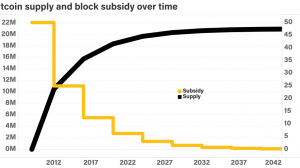Adoption take long long time, it happens through small market niches… and every huge tech company started somewhere in some tiny known or unknown market. This is how adoption is starting, not with mass market with mass marketing… which is what majority of people in the crypto space is thinking and cheering for. Adoption is number one thing, alpha and omega of every new technology. Without it, everything else is irrelevant. But it needs to start with baby steps, and I will explain to you now why this is crucial.
More than ever, people today in current culture do not know what they really want. Steve Jobs knew that is the case, I remember him saying one time: “People don’t know what they want until you show it to them. That’s why I never rely on market research. Our task is to read things that are not yet on the page.” This reminds me of famous quote: “Best way to predict the future is to create it.”
People do not know that something is cool, unless their geek friend show them and explain how cool it is. People do not know about it because network effect has not reached them yet.
If alien would come masked to ask average person if you could choose anything in the world achieve x, what would you decide to use? They will not be able to give you the answer, because they are not visionaries. Their answer would depend on the people around them, what they think is the right, best answer. Or if they already learned from others what is the “right” way to achieve X, they would go for that as answer.
Many people in crypto space think that cryptocurrency will change our society, our culture, and although they bight be right, it will not impact it in a way they assume it will. Mass adoption is something I hear way more often than I would like. Let me explain.
No one can change the culture of the masses in the US or the world. But culture of one elementary school can be changed. It happens organically: one kid brings fidget spinner, then 5 kids brings fidget spinner, then 20 kids have fidget spinner, and seems that suddenly, everyone has a fidget spinner. Then fidget spinner will start becoming popular outside this elementary school and will spread to other elementary schools, and eventually one kid will show it to kid who lives in other country, and next what you know, fidget spinner spread like a virus all around the world among kids. There is even expression “viral” when someone spreads like a virus. Memes are viral.
You will recognize great crypto projects because they are adding this multiplier that comes from culture to establishing a new culture. They ARE communicating a culture. Their team makes clear who are the people who are like them, and what the things they are making are meaning to them.
With kids, it is easier because whatever that is fun hit them, they want it. But grown-ups are way more complex in decision making. Masses will never accept innovation, or novelty… at first. Sociologists first time noticed around hundred years ago that the way ideas are spreading through society has its formula and structure.
The thing is, that adoption of novel product needs to go through certain social structures in order to become a strong brand that lasts long. If you look world around us, you will notice that people are belonging to “social milieus.” There is expression that every bird flies with its own kind.
Someone is interested in something new, some people does not want to hear about it, and someone is neutral. Before people were divided among nationality and religion, but today we have more and more divide towards time focus. According to Philip Zimbardo, who is among the biggest live psychologists today, noticed that main differences among people today is the way they perceive time. Someone is oriented towards future and new technologies, someone towards present and proven things, and someone is combination of these characteristics.
As I said before, in order for new thing to become tough and strong, it must go through the following social structures:

On this graph we see 5 types of people. X axis is time. Blue line is the amount of new people that are adopting the new thing – it can be product, brand or idea. Yellow line is total amount of people that adopted it at certain period of time. If you want to make new thing successfully adopted, it must go through this sequence, starting from innovators, no matter what is the marketing budget.
Most reliable way to determine to which group you are belonging regarding cryptocurrencies is to look at how you found out about cryptos. Note that we all are belonging to all these groups at the same time, different subjects interests different people in different way.
Innovators – are people that are adopting innovations are usually the innovators themselves. They are discovering on their own new things. Those are people with entrepreneurial spirit who are developing and creating products, ideas and brands. New thing first needs to be heard and seen among them, and that is why it is important to track the crypto projects that are exposing themselves on in the places where these people hang out, like seminars and conferences.
Early adopters – This group of people is the most important for organic spread of new thing. These people are often very oriented on future, they want to be among the first who will try everything new that arrived and they are often educated above average. They are socializing with or communicating in some way with innovators, and often find out from them about new stuff. There are not lot of them, around 13%, but they are very important.
What amazes me is that almost everyone is making mistake by skipping them!
There is one more reason why they are most important. That is because here is a chasm between the two groups of people that don’t blend well together: the early market and the mainstream market.

This chasm is the most important thing you will learn in this part because the protocol that reach the critical mass first, wins in the race towards forever monopoly. Until then, until the protocol has not crossed the chasm, everything is uncertain and first mover advantage means very little. There are many examples where the first leaders were buried. Does Yahoo!, Nokia, MySpace ring the bell? There is even book “First to market, first to fail” which is going into more details about this phenomenon.
Now, we are arriving to the biggest group, and that is majority. Mass.

Mass is divided on early and late, and main mistake of many start-ups is that they immediately want to hit on mass and skip early adopters. I also hear this way too often in crypto groups, question like When will start mass adoption, when will you advertise to the masses? That this is mistake is not my opinion, but an empirically proven thing about which you can learn in many marketing books. Of course, we are here talking about brand creation, not about sales. Brand is extremely important with innovative things, because you can not rely on selling the features of the new stuff.
Let us get back to masses. How to know when new tech is entering early majority? It has no negative stigma any more associated with it that are scaring people. Early Majority are ordinary people that are doing ordinary jobs, hanging out on ordinary places, have ordinary answers on ordinary questions. They are most often focused on present or past. During the week days after work they are spending lives on watching tv, and similar.
Masses are inert, they are hardly adopting new things and they do not possess exploring spirit, but, ideas are coming to them, but how? Now we come to divide of the mass on early and late majority. Because mass is mass no matter early or late, there is a chasm between early adopters and early majority… and innovation succeeds to spread into early majority, or not.
Early majority is different from late majority because … they are watching Netflix, not TV hehe Jokes aside, early majority is socializing with early adopters. These people have little weird but smart friend who is always doing something cool and different. Although early majority leads ordinary lives, they find early adopters interesting, they love to hear about something interesting that is breaking their everyday boring pattern. Early majority sees that early adopters are using new product, and if they like it, they will start to use it too in order to be as cool as them. That is the way how new brand is penetrating into the mass.
Late majority is not socializing with early adopters. Even more, for them they are “freaks and maniacs,” people that should be avoided because they are psychopaths and similar. Generally speaking, these people are extremely oriented on today, they are totally disinterested in anything new, and often are not very educated. Late majority is adopting new ideas from early majority, because they are interacting among themselves.
And at the end, people that are last adopting something new are Laggards. These people are like this grandpa who lives alone in house with shotgun in his hands protecting his property from strangers. If you come closer than 100 yards he SHOOTS!

So, in order for protocol to become most dominant player in the future, it needs to go through specific sequence of social layers. Apple were using this strategy intensively for decades after Steve Jobs took over Apple again, and even Microsoft started to launch new products through early adopters, because they realized that hitting directly the masses can not attain brand.
It is classical mistake to start with mass marketing. That is why I stay away from crypto projects that are launching big marketing campaigns early on. That is giving short term results and increased network effects of speculators and investors, but that is not attainable if you want to build global brand, primarily because of the attrition of users.
Whenever you see the protocol which is aiming to the global scene early on, run away as fast as you can from it. If it is trying to penetrate into old and slow institutions like governments and banks, just put X in front of their name.
This is counterintuitive thing, but it will save your ass. You are welcome!








[…] ended the post about diffusion of innovation with saying that whenever you see the protocol which is aiming to the global scene early on, run […]
[…] is continuation of diffusion of innovation which you do not need to read to understand this because I will repeat myself […]